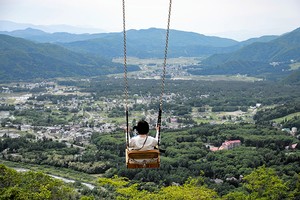By HIROMU IMABAYASHI/ Staff Writer
November 11, 2024 at 07:00 JST
MAIZURU, Kyoto Prefecture—Dubbed the “Venice of the East” on social media and elsewhere, the city is not in danger of sinking but is working to preserve its traditional landscape.
The Yoshihara district in Maizuru is a step out of time with a water channel lined with “funaya” boatsheds. These and other historical features are rooted in its distant past as a fishing district within the Edo Period (1603-1867) castle town.
The district's strip-like docks stretch out on both sides of the Yoshihara Irie waterway, which is 10 meters wide and 550 meters long, and spills into the west port in Maizuru Bay.
Spanning the channel is Minatsuki bridge—a popular photo spot for visitors who want to capture the picturesque scenery.
Yoshihara earned its online nickname thanks to views of fishing boats moored beside narrow homes.
As a district full of living history, Maizuru city hopes to eventually register Yoshihara as a state-designated protected zone for historic buildings. Its recent efforts include releasing a survey report and sightseeing map.
“A characteristic of Maizuru lies in its well-preserved town design,” said Tatsuya Matsumoto, a senior Maizuru official in charge of history, culture and town improvement. “To pass it down to posterity, we will be gearing up for the district’s designation while winning over residents’ understanding.”
PRESERVATION & PROMOTION
During the Edo Period, Yoshihara was a slice of a thriving town outside Tanabe Castle in what is now the western part of Maizuru. The district is said to have relocated to its current site from the castle town following a huge fire in 1727.
Maizuru launched its survey on Yoshihara with the assistance of Kyoto Women's University in 2020. The aim was exploring methods to conserve the area’s historical landscape, and the research report was compiled in March of this year.
The report illustrated the district’s history up to present day by comparing materials that included the local Tanabe domain’s records and a cadastral chart of land ownership from the Meiji Era (1868-1912) with findings from the on-site study.
According to the report, the structure of the district has mostly been maintained since the early Meiji Era for up to 150 years.
Among its existing historical features are the narrow docks lined with 500 houses, paths leading to the waterway and a network of streets linking boatsheds. A private home there was allegedly built as early as in the late Edo Period, too.
BOATS GALORE
A closer look at the cadastral charts from the Meiji Era and the Taisho Era (1912-1926) revealed that the funaya could accommodate upwards of 480 boats.
“The view of Yoshihara Irie, characterized by around 500 fishing boats lining the funaya, was remarkable in its magnificence,” the report states.
While no funaya from those times remain operational, some of them still retain their original appearance. As many as 70 reportedly live on as sheds, homes, storage facilities and so forth.
The report concludes that Yoshihara is “extremely rare across Japan because the former fishing town continues to maintain its initial design.”
Particularly, it called for the protection of funaya as traditional buildings to represent “essential components of Yoshihara.”
FIGHTING OVERTOURISM
In the meantime, the report estimates that “more than 40 percent of homes are left vacant” in Yoshihara, given that many residents of the district are elderly couples or live alone.
However, as 16 fishermen were working in Yoshihara as of 2020, the report demands that the area be protected as “an active fishing town.”
With potentially cramped roads in Yoshihara in mind, the report cites the need for countermeasures against an excessive influx of tourists as a particularly urgent challenge to overcome.
Maizuru took the report into account when it commissioned Kyoto Women's University to create a Yoshihara walking map in an endeavor to showcase the district’s life, buildings and attractions.
The map is available on the websites of the municipality and the university while 2,000 paper copies were made and distributed in September; they can be found at the city government office and elsewhere.




















A peek through the music industry’s curtain at the producers who harnessed social media to help their idols go global.
A series based on diplomatic documents declassified by Japan’s Foreign Ministry
Here is a collection of first-hand accounts by “hibakusha” atomic bomb survivors.
Cooking experts, chefs and others involved in the field of food introduce their special recipes intertwined with their paths in life.
A series about Japanese-Americans and their memories of World War II